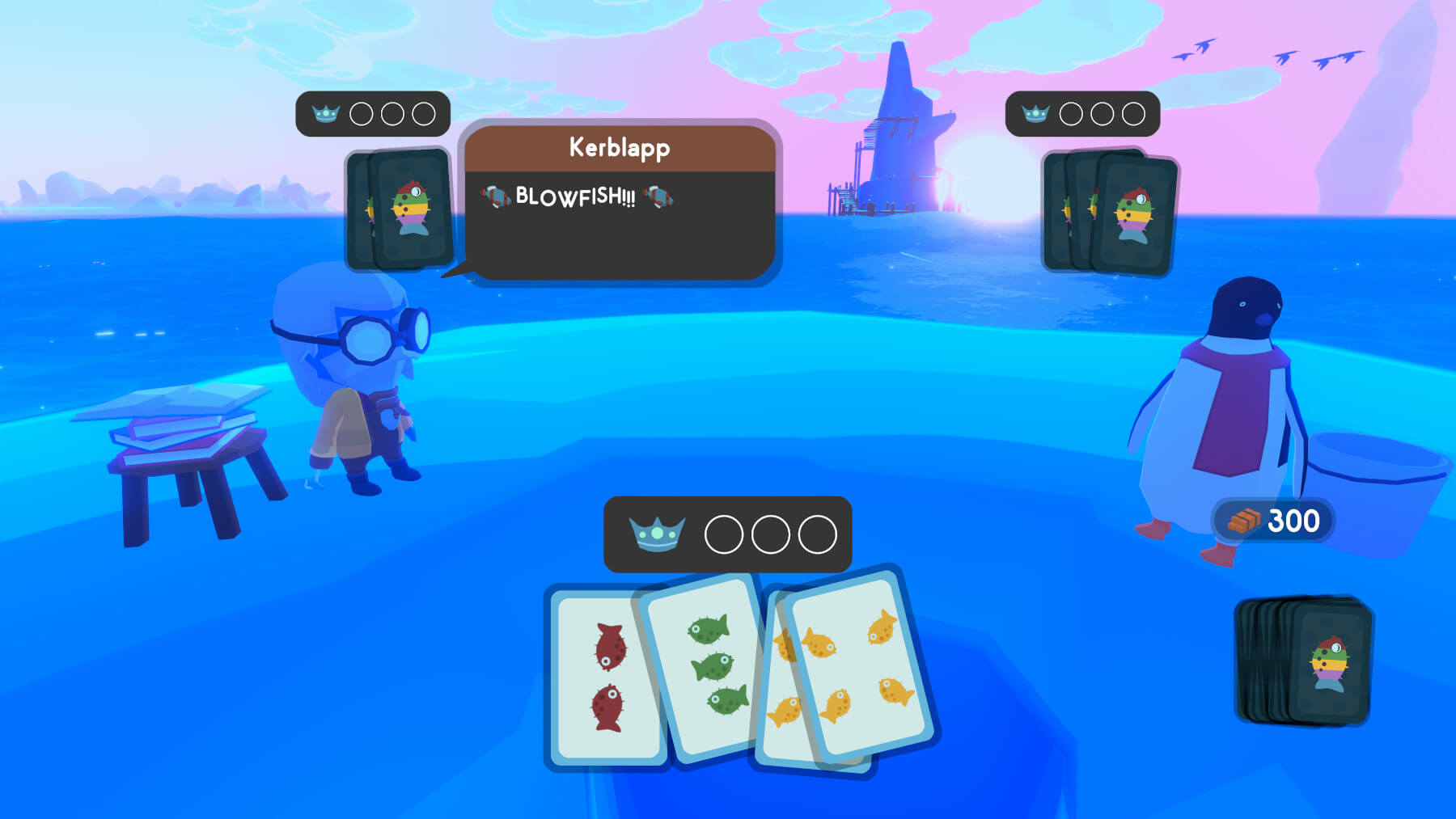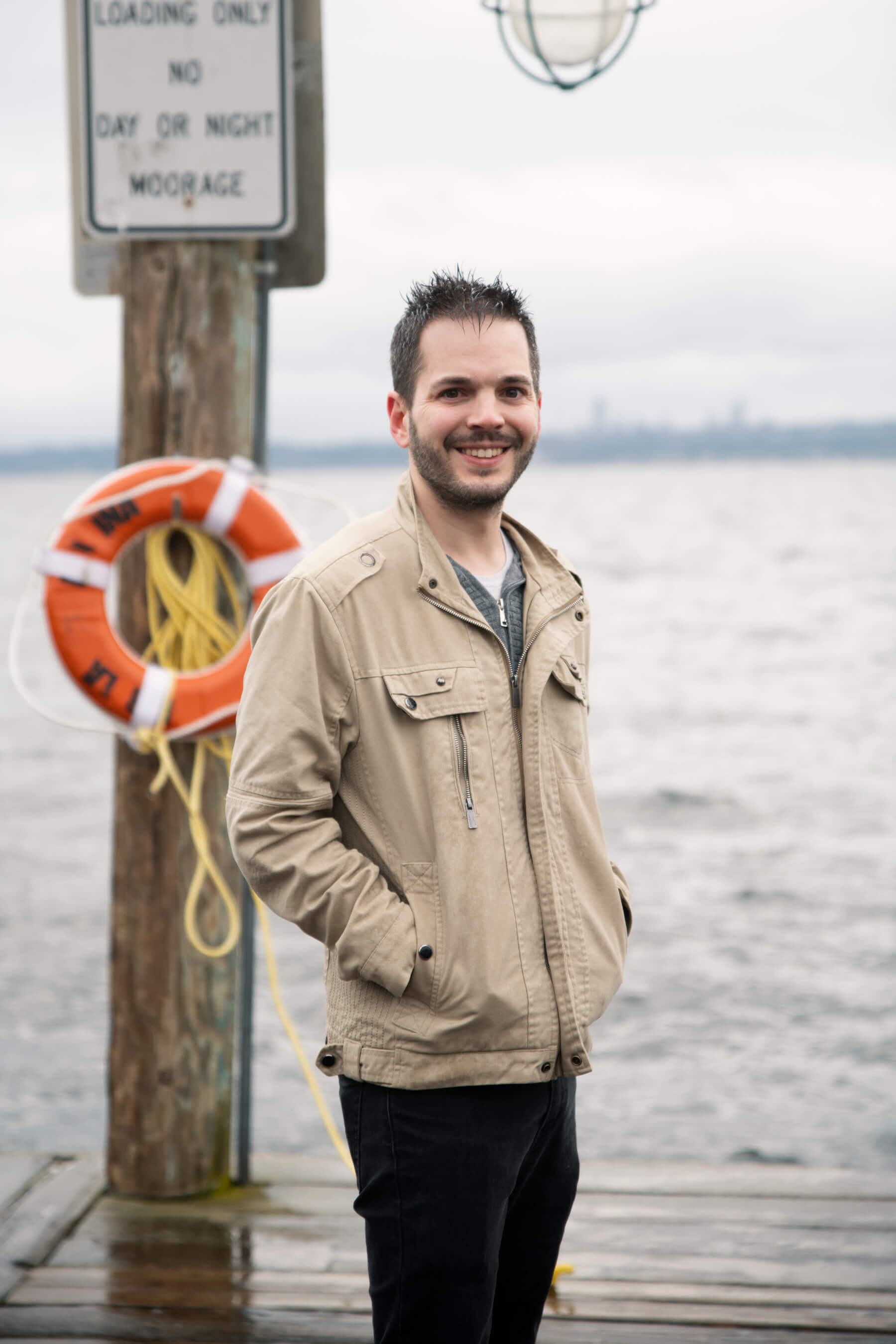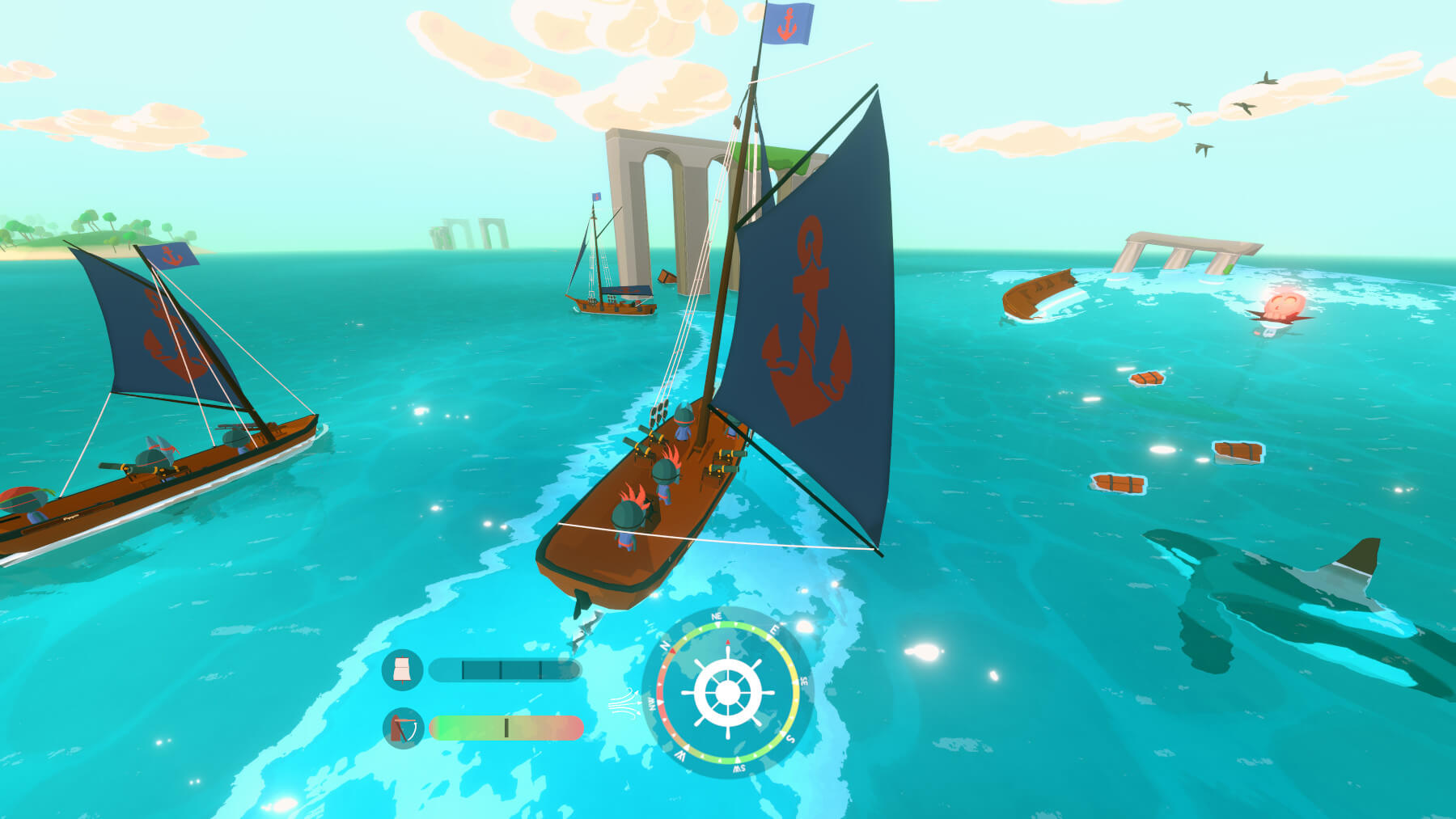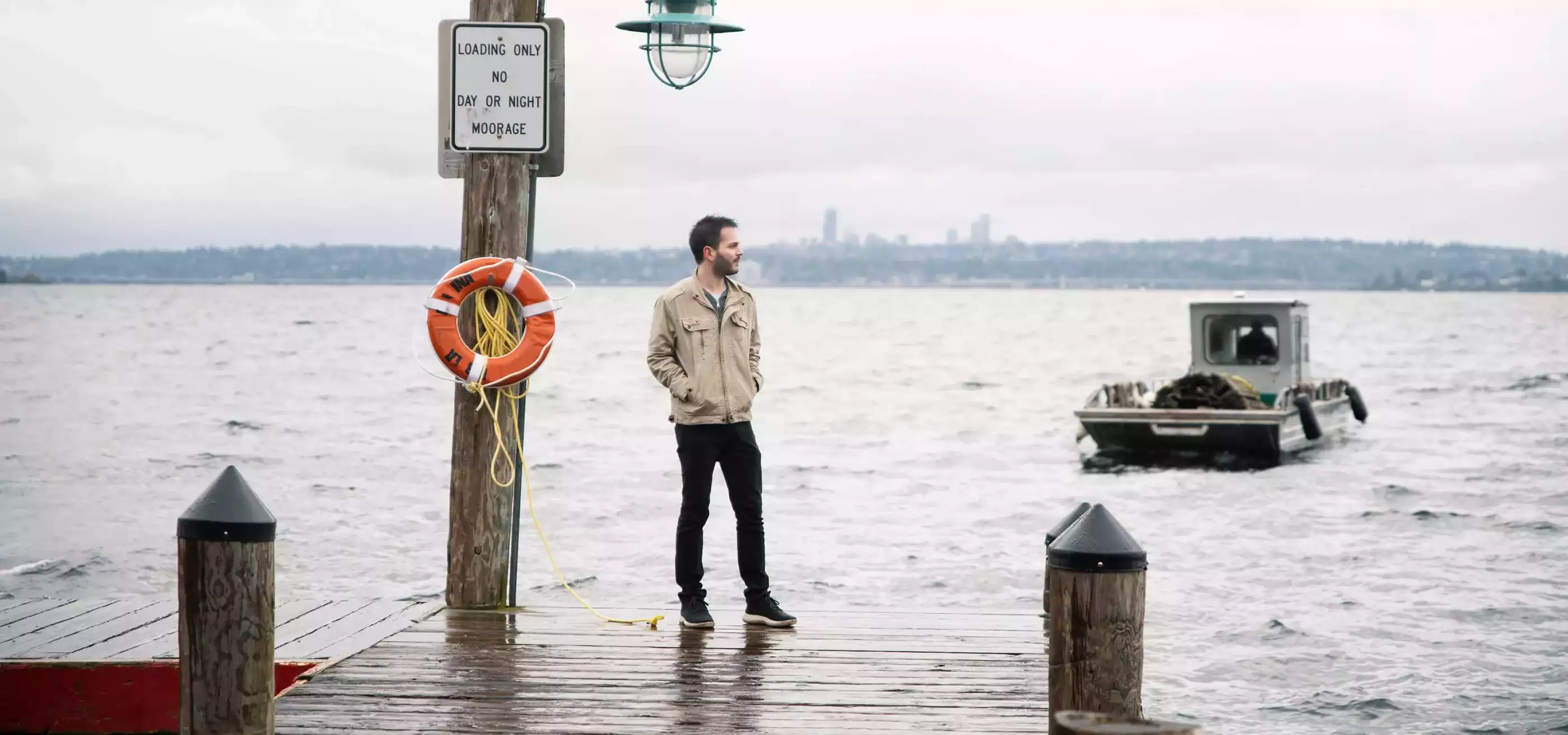It was 2016 when DigiPen graduate David Evans first began playing around with an idea for a game about sailing.
“It was just called ‘Boat Game’ for the first several years,” Evans says. “It wasn’t a particularly thought-out idea or anything. I was just messing around with boats. I had this vague idea that I wanted to make some kind of sailing simulator.”
The idea wasn’t entirely random. As a kid, Evans would often accompany his dad, a sailing enthusiast, on brief excursions aboard his 20-foot sailboat. Together, they used the winds and gusts to travel across the waters of the Puget Sound and Lake Washington. Unsurprisingly, Evans found himself drawn later in life to video games with sailing mechanics. Despite the familiar thrill those games provided — be it charting the oceanic wonders in The Legend of Zelda: The Wind Waker or navigating the historical West Indies in Assassin’s Creed IV: Black Flag — the experience always felt lacking.
“I liked sailing in other games, but it never quite behaved the way that I wanted it to. So I just wanted to see if I could make something on my own that felt good,” Evans says.
Roughly six years later, that “vague idea” would eventually culminate last December with the release of Sail Forth, a downloadable indie adventure available for PC, Xbox, PlayStation, and Nintendo consoles. With a few notable exceptions, it’s a game Evans created almost entirely on his own — providing all of the game’s core programming, art, and design.
Described by Evans as a “chill sailing adventure,” Sail Forth is a game in which you, the player, must navigate and explore a sprawling watery expanse of deserted islands, pirate strongholds, sunken ruins, and more — all while assembling a small fleet of seafaring vessels and companions. As you make your way steadily northward, you’ll slowly uncover the mysteries of this waterlogged world, known by its quirky inhabitants as the Deepblue.
Whether engaging in sea skirmishes, scavenging for treasure, or taking on the occasional side quest, the shifting moment-to-moment gameplay remains anchored to the core sailing mechanics that inspired Evans from the beginning. New players will quickly discover there’s more to getting their boat from point A to point B than merely aiming the bow towards a destination and pushing straight forward. They instead must pay attention to the changing wind patterns and trim the ship’s sails accordingly.
“You’re meant to really feel like you’re controlling a boat and feel the excitement when the wind fills your sails,” Evans says. “There’s a nice effect when that happens and you see the boat lean over, and it’s all designed to make sailing feel cool.”
Despite Sail Forth being a mostly solo endeavor, Evans had some help. Much like the game’s protagonist Captain Toot, who wakes up alone at sea before assembling a friendly crew, Evans managed to recruit various friends and family members to assist along the way. That included former DigiPen classmates such as Andrew Nack, a fellow polymath who crafted the game’s music and audio effects, as well as Silvia Elizabeth Ocana, a 2014 graduate from the BFA in Digital Art and Animation program who provided early concept art.

“She drew these concepts for these little blue people, and I really liked them, so that influenced the style of all the characters in the game,” Evans says. “That whole part of the game, of just being able to work with all my friends, was really fun.”
While the scope of Sail Forth certainly outgrew anything Evans had attempted before, it wasn’t his first foray into indie development. In fact, Evans had been making games ever since his teenage years. That’s when he began applying his mostly self-taught programming knowledge to a range of hobbyist projects — albeit with limited success.
“I would often try to make a project and then end up having to scrap it, because I just couldn’t execute on it. I would get stuck on something, either a technical thing or a design thing, and I couldn’t figure out what to do,” Evans says.
I felt like I was learning so much so fast, like someone had opened up my brain and was just dumping knowledge in there. It was very exciting.
That frustration would eventually lead him to attending DigiPen, where he enrolled in the BS in Computer Science in Real-Time Interactive Simulation degree program.
“I wanted to clear that blocker for myself, and I thought if I go to DigiPen, maybe I’ll learn enough that that won’t be a problem anymore. And that was definitely what happened,” he says. “I felt like I was learning so much so fast, like someone had opened up my brain and was just dumping knowledge in there. It was very exciting.”
After graduating from DigiPen in 2013, Evans accepted a job offer at Microsoft, where he initially worked on web-based technologies before moving to the HoloLens development team responsible for making augmented reality prototypes and tech demos. All the while, Evans continued to work on his own games on the side. In 2015, he and a few friends released Bicyclism EP, a humorous game where multiple players race bikes by way of a deliberately awkward control scheme.

“It was fun to work on, but it just went nowhere. We didn’t know what we were doing, and we didn’t know how to market anything,” Evans says.
By the time he began work on Sail Forth, Evans admits he had no grand vision or expectations for what the game should be.
“I was just adding things kind of willy nilly,” he says. “Whatever the next thing that popped into my head of like, ‘Oh, that would be fun to add, or that would be fun to work on,’ I would just do that.”
His meandering approach led to various ebbs and flows in the overall shape of what Sail Forth would gradually become. Early roguelike design ideas were abandoned, while certain genre elements — like procedurally generated environments — remained. Complex sailing mechanics became slowly whittled down in favor of a more player-friendly approach. Eventually, the game became big and defined enough that he could begin to see an end goal. Having already established a publishing arrangement with his indie developer friend at the Quantum Astrophysicists Guild, Evans decided to leave his job at Microsoft in 2020 to work on finishing Sail Forth full-time.
“I thought that it would be done maybe at the end of that year, but it took two more years to finish the game,” he recalls.
Instead of winding down, however, Evans and his publishing partner decided to expand the scope of the game considerably by hiring a writer, another friend of Evans, who would go on to craft the game’s story, dialogue, and flavor text. While the addition of narrative helped structure and focus the overall gameplay experience, it also resulted in a huge influx of work.
“I’m happy with how it came out, but in terms of the efficiency of doing the work, I was not prepared,” Evans says. “There was definitely a valley that I hit. I think the worst part was when I was in the slog of implementing the story, and it was just endless scripts.”
To compensate for the more tedious stretches, Evans found opportunities to lean into the aspects of the project that kept him excited. When he found himself struggling to manually animate the complex movements of the game’s final boss, he devised a tool to handle the animation procedurally — a time-consuming method that nevertheless reignited his motivation and led to more satisfying results. In another instance, when Evans faced the prospect of having to generate unique art assets for 36 collectible fish, he approached the task like a fun 30-day drawing challenge, generating one fish per day for a little over a month.

“For me, it was about figuring out where the fun is. Like what’s the thing that gets you excited to work on it? And then figure out if there’s a way that you can work that into the plan,” he says.
Even though the game has released, Evans hasn’t quite reached landfall. For now, the end point to his epic indie dev adventure remains somewhere on the horizon. With the help of bug reports and player data, he still spends a good portion of his days working on post-launch fixes and improvements. He’s also hinted at new content to be introduced later this year.
“It hasn’t felt like this massive change for me yet. It does feel good, and it’s cool seeing everyone playing and seeing positive reviews,” he says. “It’ll feel weird to say goodbye to working on it.”
***
For more insight on the making of Sail Forth, check out our guest interview with Evans on The DigiPen Show on Twitch.
